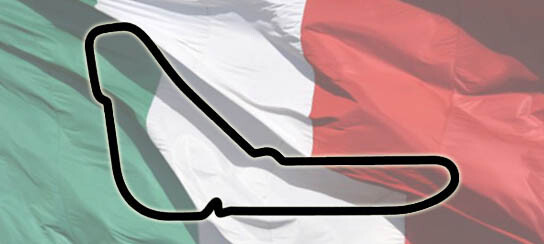BIOGRAPHY
From the beginning, Monza was an important venue and since 1922 has hosted the Italian GP almost every year. Indeed, its opening caused members of the Brescia Automobile club to instigate the Mille Miglia. Brescia had lost its previous high status in Italian motor sport with the coming of Monza. There was also ancient rivalry in that Monza is in Piedmont and Brescia is in Lombardy.
This level of passion has long been a feature of Italian racing and is nowhere better experienced than at Monza when Ferrari is present. The word is 'present', not 'racing', the tifosi will turn out by the ten thousand just for testing.
Like many other circuits, Monza has not been a single layout, but a series of more than a dozen layouts which have ranged in length from 1.482 miles to 6.214 miles. The circuit was opened in the Monza Royal Park, near Milan, in 1922 and featured banking, though these were demolished in 1939. The banking which featured in some races, 1955-69, were new structures built on the format of the original. The banking was used for the Italian GP in 1955, '56, '60 and '61, and was last used for racing of any form in 1969 when the concrete became in need of substantial resurfacing and rebuilding.
From 1950 to 1954, the purely road circuit was 3.915 miles long, but the layout was eased, slightly shortened (to 3.571 miles) and made faster for 1957 and 1958. That is not a misprint, the track was made faster and also easier to overtake on.
Between 1962 and 1971 this revised circuit provided an opportunity for high-speed racing with lots of slipstreaming and overtaking. The 1971 Italian GP holds the record for the fastest-ever Formula One race but, emphatically, that is not the same as saying the fastest race for Grand Prix cars. Though you would not know it to listen to some people, that honour remains in the possession of the 1937 Avusrennen.
After 1971, the circuit underwent further revisions to discourage slipstreaming and to lower the average lap speed. Chicanes were added in 1976 and, in 1994, the second Lesmo Bend was tightened and the Curve Grande was re-profiled.
In 2000, the chicane on the main straight was altered, changing from a double left-right chicane to a single right-left chicane, in an attempt to reduce the frequent accidents at the starts due to the conformation of the braking area. The second chicane was also re-profiled. In the Grand Prix of the same year however, the first to use the new chicanes, a marshal, Paolo Gislimberti, was killed by flying debris after a major crash at the second chicane.
In 2007, the run off area at the second chicane was changed from gravel to asphalt. The length of the track in its current configuration is 3.599 miles.
The fastest ever Formula One lap of Monza in its current configuration, was set during the 2004 Italian Grand Prix, when Rubens Barrichello (Ferrari) posted a time of 1:20.089, thereby averaging 159.891 mph.
Over the years, the circuit has witnessed many fatal accidents, especially in the early years of the Formula One World Championship, and has claimed the lives of 52 drivers and 35 spectators.
Despite the numerous modifications to improve safety and reduce curve speeds it is still criticised by drivers for its lack of run-off areas, most notoriously at the chicane that cuts the Variante della Roggia.
Every Formula One circuit has its own charm and excitement, from Monaco, with its glitz, glamour and casinos to the deserts of Bahrain. Yet the Italian GP, at Monza, the home of Ferrari, remains, to many, one of the highlights of each season.
Fast Facts - Provided by the FIA
2018 marked the 69th Italian Grand Prix. The race has been an ever-present on calendar since the inaugural Formula One World Championship in 1950 and all but one Italian Grand Prix has been held at Monza. The race moved to Imola in 1980 while renovation work was carried at the
circuit outside Milan.
Michael Schumacher is the most successful driver at this event. The German has five wins to his name (1996, 1998, 2000, 2003, 2006) and all were recorded at Monza. Nelson Piquet is next on the list with four wins. The Brazilian is the only driver to have taken an Italian GP win away from Monza, winning that sole Imola event for Brabham.
Ferrari is the most successful team, with 18 victories. McLaren holds second place with 10 wins, while Willliams are third with six victories.
Seven drivers have taken their first Formula One win in Italy. Sebastian Vettel is the most recent, winning for Toro Rosso in 2008. The others are Juan Pablo Montoya (2001), Peter Gethin (1971), Clay Regazzoni (1970), Ludovico Scarfiotti (1966), Jackie Stewart (1965) and Phil Hill
(1960).
Just two manufacturers have landed a maiden win in Italy, and curiously both outfits are Italian. Juan Manuel Fangio gave Maserati the first of nine F1 wins at Monza in 1953, while Vettel's '08 was the first and only win to date for Toro Rosso.
This year marks the 51st anniversary of Honda's only Italian Grand Prix victory to date as a constructor. The team's 1967 win came courtesy of late F1 great John Surtees. At the wheel of the V12-powered RA300 car, Surtees claimed the lead on the finish straight in a thrilling end to the race, beating Jack Brabham by just two tenths of a second.


